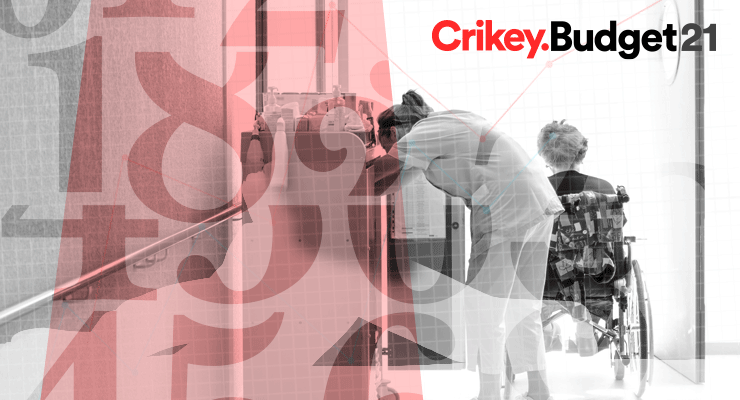
Despite a major increase in aged care funding, there are serious questions about whether the Morrison government will deliver the fundamental reform needed to implement the recommendations of the aged care royal commission and achieve what it calls a “generational plan for aged care”.
There will be a big rise in aged care funding: by 2024-25, over $31 billion will be spent on the sector, compared to less than $20 billion in 2019-20. Where is it going?
- An additional 40,000 home care packages from next year, and a further 40,000 in the following year, costing $6.5 billion over four years
- $3.9 billion over four years to implement a requirement — long demanded by nursing unions — for minimum care requirements in residential care: by October 2023 residential facilities will have to provide 200 minutes per day of care, including 40 minutes with a registered nurse
- $3.2 billion over four years to increase the Government Basic Daily Fee per resident paid to residential providers by $10 a day, to be rolled into a new funding model, the Australian National Aged Care Classification (AN-ACC). That will cost $189.2 million separately.
That’s just the initiatives worth more than a billion dollars.
But the key questions in addition to those initiatives — and behind some of them, such as the home care expansion and the minimum care requirements — are about workforce. It’s here that issues start to arise.
There’s around $228 million to improve the quality of the aged care assessment workforce, $91.8 million for training of an expanding home care workforce, $49.4 million for palliative and dementia care, $27.3 million to fund 1650 new training places for both nurse and non-nurse carers, plus funding for an additional 33,800 training places for personal care workers to attain a Certificate III in Individual Support (Ageing).
Out of all those initiatives, few are explicitly intended to lure more workers into the aged care workforce. The minimum care requirements will need more staff to implement, including more nurses. The increase in the Basic Daily Fee will give residential providers more money to offer better salaries — but there is little in the way of direct incentives for people to take up aged care as a career path.
The government appears to be hoping that its increase in the Basic Daily Fee will automatically flow through to higher pay for a workforce that has gone backwards in terms of casualisation in recent years — as we learnt to our cost in the pandemic.
That’s not to criticise what represents a serious attempt to engage with the royal commission recommendations and the logic behind them. In particular, the Coalition has overthrown decades of government policy that refused to implement minimum care standards, by imposing a 200 minute requirement. It offers substantial funding to help seniors navigate the system. It offers significant funding to address service delivery failures for Indigenous seniors. It provides funding to drive a professionalisation of the workforce by increasing training support around Certificate III.
And it embraces some of the institutional recommendations of the royal commission. It takes commissioner Lynelle Briggs’ line on structural reform of oversight, rather than Tony Pagone’s “blow up the lot” approach.
The Department of Health will retain overall control of the sector but there’ll be a National Aged Care Advisory Council, Council of Elders and an inspector-general of aged care. The Independent Hospital Pricing Authority will be expanded to embrace aged care (also a Briggs recommendation) in order to move the sector to a better pricing model. There’ll be a new, rights- based aged care act, which is central to the recommendations.
And the Aged Care Quality and Safety Commission will get more than a quarter-of-a-billion dollars over four years to improve a body that demonstrably failed during the pandemic and which is widely seen as ineffectual in a sector riven with poor quality care and terrible outcomes for seniors.
But the challenge of finding the workers to deliver improved standards in a better funded sector remains. Nowhere does the government address the reliance of the sector on temporary migrant workers, without whom the sector will struggle to maintain existing staffing levels let alone provide the big rise in staff required by an ageing population and the government’s reforms.
As with so much of what this government announces, the announcement is impressive, but the delivery is the worry. Just consider these “smaller” ideas:
- $272.5 million for people to help seniors navigate the care system
- $365.7 million to improve access to primary health care and other health services
- an increase of $262.5 million for the widely criticised regulator, the Aged Care Quality and Safety Commission
- $200 million for a new star rating system for aged care facilities
- $67.5 million for dementia behaviour management
- $630 million to target vulnerable seniors in regional and remote Australia, obviously targeting Indigenous seniors.
There is much to do, but who will be doing it?








Maybe the third world has a better system? Perhaps if the oldies were looked after at home in and by their families, all this money could pay the mortgages? Something like that. Just a thought.
Whichever way you look at it, old peoples’ homes are a weird and not wonderful invention. A bit like school: get them out of the way. Healthy adults command. I don’t think women would have invented either institution. But now that we’re stuck with them we really should make them pleasant places. Start with adequate pay for full time professional staff. As we’re not doing that, even now, the abuse and starvation will continue.
Oh well. (Sticks head back in sand.)
LNP DGAF Never Have Never Will